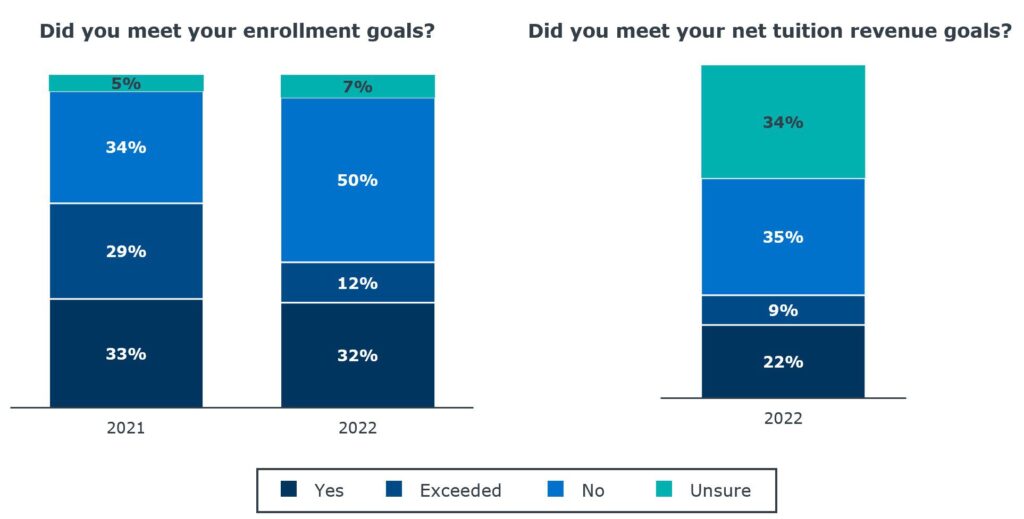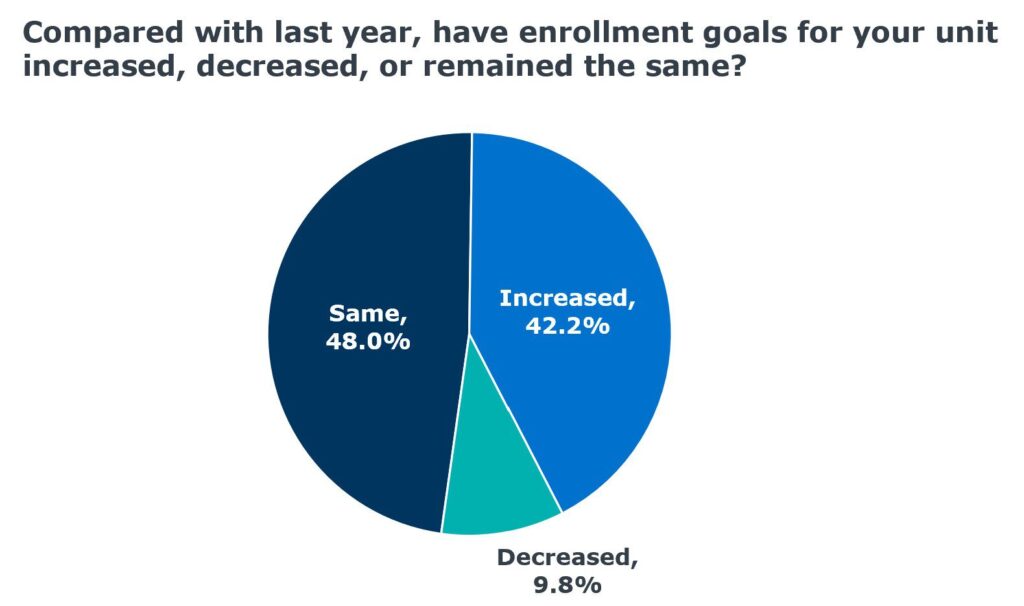Why half of graduate enrollment leaders didn't meet their goals
For nearly the last decade, graduate enrollment has reliably increased each year. However, after a bump during the pandemic, enrollments declined in 2022, which now leaves many enrollment leaders in unknown territory when it comes to setting enrollment goals.

We asked graduate enrollment leaders about their experiences with goal setting in the second survey of the series we’re conducting with NAGAP. Three themes emerged, painting a picture of a challenging environment for goal attainment over the past year.
1. Fewer graduate programs met their enrollment goals
Our survey found that a staggering 50% of surveyed graduate enrollment leaders did not meet their enrollment goals in 2022, and 35% did not meet their net tuition revenue goals. We also saw important differences by institution control: 59% of private institutions said they did not meet their enrollment goals, compared to 42% for public institutions. And net tuition revenue reflects a similar trend, with 46% of private institutions and 25% of public institutions saying they did not meet their goals.
Our research also found that the smaller the institution, the less likely they were to meet their net tuition revenue goals. Forty-nine percent of institutions with enrollment under 1,000 reported not meeting their net tuition revenue goals, compared to 35% for institutions with enrollment between 1,000 and 4,000, and 28% for institutions with enrollment above 4,000.
Regardless of institution type or size, it is clear that the “if you build it, they will come” strategy is no longer sufficient. Graduate programs are tasked with meeting substantial enrollment and revenue goals, but often face budget, resource, and staff limitations in reaching those goals. And graduate students are taking complex, non-linear, and stealth journeys to enrollment. In order to reach and enroll these students and achieve graduate growth, graduate enrollment leaders must devote time, money, and planning to these programs.

BUILDING AN EFFECTIVE GRADUATE ENROLLMENT MANAGEMENT PLAN →
2. Enrollment priorities have largely stayed the same—but enrollment goals have increased
Graduates leaders’ top priorities-higher enrollments, more revenue, greater diversity, and a higher percentage of online students-have remained consistent from 2021 to 2022. While priorities haven’t changed, enrollment targets have increased.

This continued emphasis on enrollment and net tuition revenue growth comes as no surprise. While still a primary source of income, undergraduate enrollment has been declining as fewer students enter college and more transfer or drop out. Because of this shift in revenue, universities are continuing to turn to graduate programs to fill the budget gap left by decreasing undergraduate program funding.
In addition, the effects of the pandemic continue to reverberate across institutions and have shifted enrollment objectives. To meet student preferences and demands, colleges are more actively pursuing diversity and access, in addition to flexible offerings, as part of their recruitment efforts.

SETTING REALISTIC ENROLLMENT GOALS →
3. Enrollment leaders who had more input in goal setting were more likely to meet their goal
Our survey revealed an interesting connection between graduate enrollment leaders’ input into their goals and their ability to meet them. Graduate leaders who reported having a “great deal” of input in setting their team’s enrollment goals were more likely to indicate that they were on track to meet their enrollment goals next semester (53%). This was in stark contrast to participants who had “little” input, 25% of whom reported being on track, or “no” input, 27% of whom were on track.
Participants with a “great deal” of input were also more likely to think that they enrollment targets were realistic (97%) compared to leaders with a “good amount” (66%), “moderate” (52%), “little” (57%), or “no” (57%) input.
Lastly, a sizable share (35%) of graduate enrollment leaders think enrollment targets are too high. Unsurprisingly, perceived ability to meet goals has major implications for graduate enrollment leaders’ job satisfaction: 44% of respondents in our first survey said unrealistic goals were contributing to workplace stress. This finding also aligns with data from a recent EAB survey of university executives, 41% of whom that said “the most difficult aspect of [their] operations due to the COVID-19 pandemic” were setting realistic enrollment goals.
Responses from the survey lead us to an an obvious conclusion: it’s crucial to involve graduate enrollment leaders in the goal-setting process both to develop realistic targets and increase buy-in.
How your institution can adapt
To ensure your institution is supporting your graduate enrollment goals, consider these three steps:
- Invest in graduate programs in order to meet growth goals: Teams need to implement a strategic enrollment management plan that includes key considerations such as market assessments, comprehensive marketing and recruitment, and student success and retention planning.
- Set smart and realistic enrollment goals: Track progress with monitoring and evaluation, and welcome feedback from stakeholders to identify areas for improvement.
- Involve grad enrollment leaders in goal setting early and often: Empowering your staff to use their voice and assist in goal setting can make a big difference in the overall performance of the grad programs and in staff morale.
Ultimately, institutions should set ambitious but achievable goals to create a roadmap for successful planning and management. This can assist in improving student outcomes, financial sustainability, and overall success.

More Blogs

4 questions domestic students will ask before applying to your graduate program

When Grad PLUS disappears: What 8,000+ grad students said about paying for school
